- NTSB votes Tuesday on cause of 2013 Asiana crash in San Francisco
- Focus is on pilots' actions, automation
- Pilots confused by auto-throttle modes
- Will blame fall on pilots or designers?
(CNN) -- When federal safety investigators meet on Tuesday to determine the cause of the Asiana Flight 214 crash, they will have studied not only last summer's deadly accident but also a little-known incident years earlier.
In August of 2010, Eugene Francis Arnold, one of the Federal Aviation Administration's top test pilots, was descending into Seattle's Boeing Field when he leveled off to avoid another plane.
To his surprise, his speed fell 10 or 15 knots below his target speed, even though he believed the jet's automated speed control, or auto-throttle, was engaged.
Arnold pushed the throttle manually to increase the plane's speed and landed safely.

 In this handout photo released by the National Transportation Safety Board, Asiana Airlines Flight 214 sits just off the runway at San Francisco International Airport on Sunday, July 7. The Boeing 777 coming from Seoul, South Korea, crashed on landing on Saturday, July 6. Three passengers, all girls, died as a result of the first notable U.S. air crash in four years.
In this handout photo released by the National Transportation Safety Board, Asiana Airlines Flight 214 sits just off the runway at San Francisco International Airport on Sunday, July 7. The Boeing 777 coming from Seoul, South Korea, crashed on landing on Saturday, July 6. Three passengers, all girls, died as a result of the first notable U.S. air crash in four years.  A photo showing the damaged interior of the aircraft was released by the NTSB on July 7. The flight carrying 291 passengers and 16 crew took off from Shanghai and stopped in Seoul before heading to San Francisco.
A photo showing the damaged interior of the aircraft was released by the NTSB on July 7. The flight carrying 291 passengers and 16 crew took off from Shanghai and stopped in Seoul before heading to San Francisco.  An investigator photographs part of the landing gear at the crash site in a handout released on July 7. Investigators believe that the pilots were flying too slow and too low as they neared the airport on July 6.
An investigator photographs part of the landing gear at the crash site in a handout released on July 7. Investigators believe that the pilots were flying too slow and too low as they neared the airport on July 6.  An investigator inspects the broken-off tail of the plane in a handout photo released July 7. The crash killed two people, injured 182 and forced the temporary closure of one of the country's largest airports.
An investigator inspects the broken-off tail of the plane in a handout photo released July 7. The crash killed two people, injured 182 and forced the temporary closure of one of the country's largest airports. 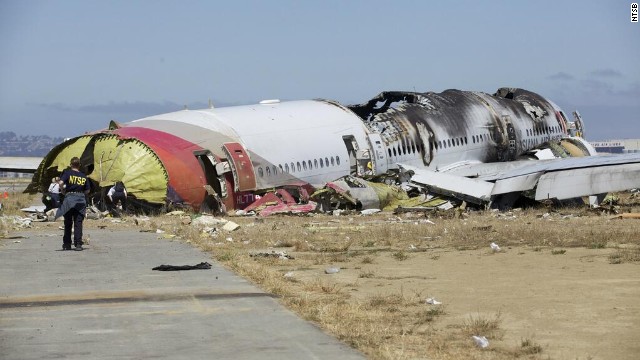 An investigator stands near the tail of the plane in a handout photo released on July 7. The NTSB has ruled out weather as a problem and said that conditions were right for a "visual landing."
An investigator stands near the tail of the plane in a handout photo released on July 7. The NTSB has ruled out weather as a problem and said that conditions were right for a "visual landing."  Investigators approach the crash in a handout photo released on July 7.
Investigators approach the crash in a handout photo released on July 7. 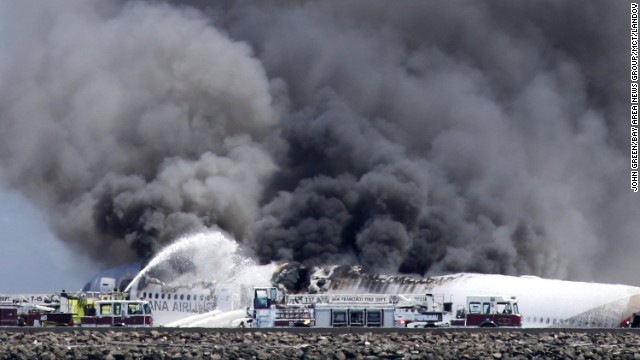 Fire crews attempt to quench the blaze on Saturday, July 6.
Fire crews attempt to quench the blaze on Saturday, July 6.  Smoke rises from the crash site across the San Francisco Bay on July 6.
Smoke rises from the crash site across the San Francisco Bay on July 6.  Asiana Airlines Flight 214 remains on the runway on July 6.
Asiana Airlines Flight 214 remains on the runway on July 6. 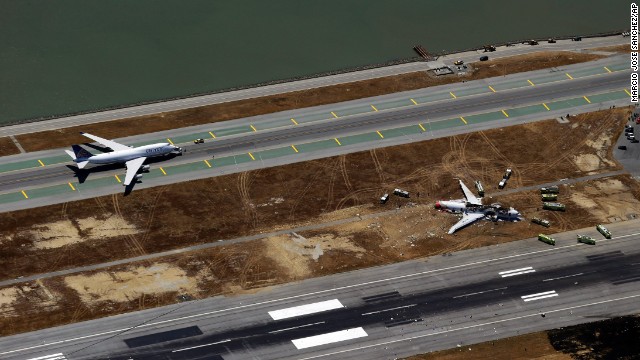 A plane sits on the runway on July 6 while emergency crews tend to the crash site.
A plane sits on the runway on July 6 while emergency crews tend to the crash site.  A helicopter flies above the wreckage on July 6 as people observe from across the waters of San Francisco Bay.
A helicopter flies above the wreckage on July 6 as people observe from across the waters of San Francisco Bay.  Travelers at San Francisco International Airport look at the departures and arrivals board after Asiana Flight 214 crashed on July 6. The airport, located 12 miles south of downtown San Francisco, is California's second busiest, behind Los Angeles International.
Travelers at San Francisco International Airport look at the departures and arrivals board after Asiana Flight 214 crashed on July 6. The airport, located 12 miles south of downtown San Francisco, is California's second busiest, behind Los Angeles International. 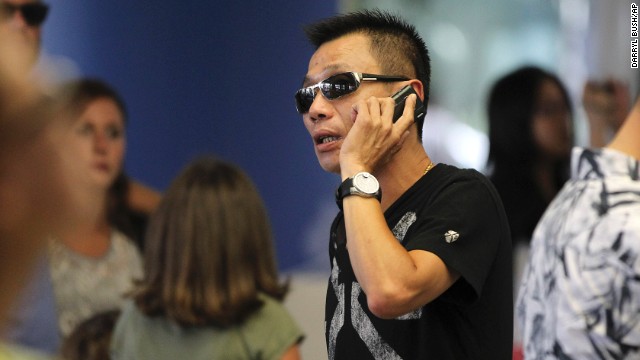 Kevin Cheng talks on his phone as he waits in the terminal after Asiana Airlines Flight 214 crash-landed on July 6. He said he was supposed to pick up students who were on board the flight from Seoul.
Kevin Cheng talks on his phone as he waits in the terminal after Asiana Airlines Flight 214 crash-landed on July 6. He said he was supposed to pick up students who were on board the flight from Seoul.  Passengers wait for the British Airways counter to reopen at San Francisco International Airport on July 6.
Passengers wait for the British Airways counter to reopen at San Francisco International Airport on July 6.  Police guard the Reflection Room at the San Francisco airport's international terminal, where passengers from Asiana Airlines Flight 214 were reportedly gathering after the crash landing on July 6.
Police guard the Reflection Room at the San Francisco airport's international terminal, where passengers from Asiana Airlines Flight 214 were reportedly gathering after the crash landing on July 6.  People are escorted from the Reflection Room at the San Francisco International Airport on July 6.
People are escorted from the Reflection Room at the San Francisco International Airport on July 6.  Traffic backs up on U.S. Route 101 South in San Francisco on July 6. The Bay Area airport was closed to incoming and departing traffic after the crash, according to the Federal Aviation Administration.
Traffic backs up on U.S. Route 101 South in San Francisco on July 6. The Bay Area airport was closed to incoming and departing traffic after the crash, according to the Federal Aviation Administration. 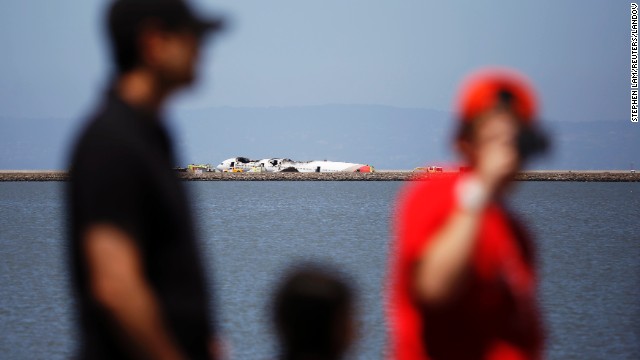 People look over the wreckage across a cove in San Francisco Bay on July 6.
People look over the wreckage across a cove in San Francisco Bay on July 6. 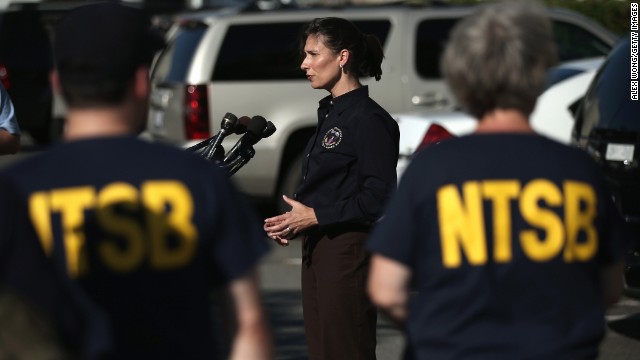 Deborah Hersman, chairwoman of the National Transportation Safety Board, speaks to the press at Reagan National Airport in Arlington, Virginia, before departing for San Francisco with an NTSB crew on July 6 to investigate the crash site.
Deborah Hersman, chairwoman of the National Transportation Safety Board, speaks to the press at Reagan National Airport in Arlington, Virginia, before departing for San Francisco with an NTSB crew on July 6 to investigate the crash site. 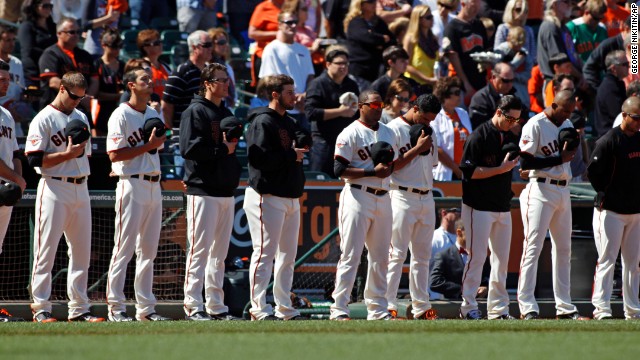 The San Francisco Giants observe a moment of silence for those killed and hurt in the crash before their baseball game on July 6 against the Los Angeles Dodgers at AT&T Park in San Francisco.
The San Francisco Giants observe a moment of silence for those killed and hurt in the crash before their baseball game on July 6 against the Los Angeles Dodgers at AT&T Park in San Francisco. 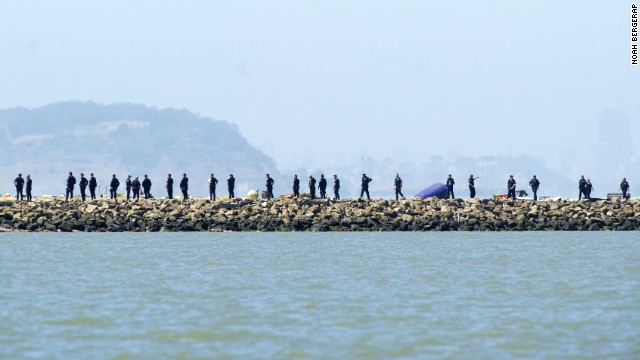 Crews comb the end of a San Francisco airport runway following the crash landing on July 6.
Crews comb the end of a San Francisco airport runway following the crash landing on July 6.  People in Seoul watch a news program reporting about the crash landing on July 6 in San Francisco. Asiana Airlines Flight 214 took off from Seoul earlier Saturday.
People in Seoul watch a news program reporting about the crash landing on July 6 in San Francisco. Asiana Airlines Flight 214 took off from Seoul earlier Saturday.  The plane crashed on July 6 around 11:30 a.m. (2:30 p.m. ET).
The plane crashed on July 6 around 11:30 a.m. (2:30 p.m. ET).  People walk past the wreckage of the plane's tail on July 6.
People walk past the wreckage of the plane's tail on July 6.  The burned-out plane remains on the runway on July 6. Passengers and crew members escaped down the emergency inflatable slides.
The burned-out plane remains on the runway on July 6. Passengers and crew members escaped down the emergency inflatable slides. 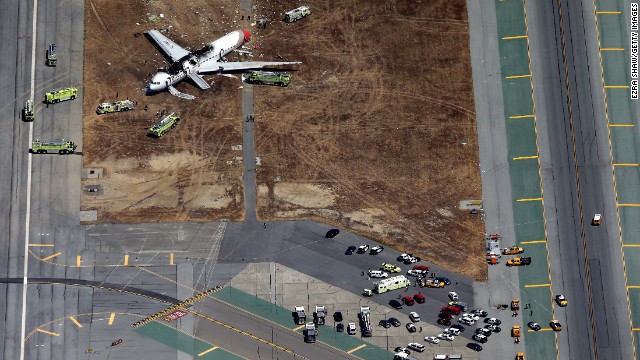 Rescue workers tend to the crash site on July 6.
Rescue workers tend to the crash site on July 6. 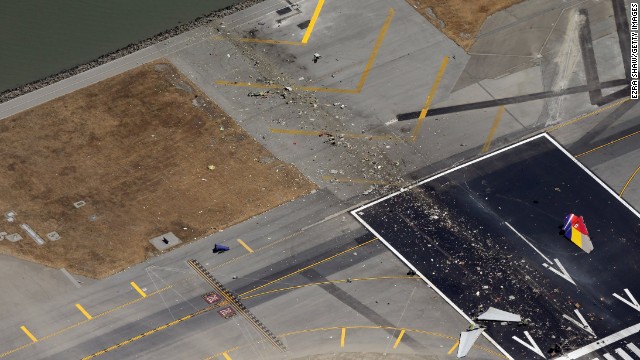 Debris litters the runway on July 6.
Debris litters the runway on July 6. 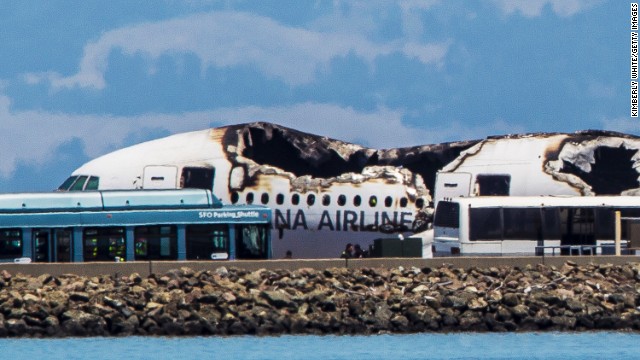 Airport shuttles arrive on the scene after the crash landing.
Airport shuttles arrive on the scene after the crash landing. 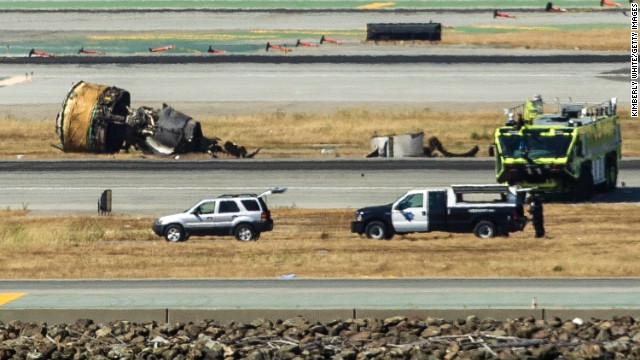 Wreckage from the Boeing 777 lies on the tarmac on July 6.
Wreckage from the Boeing 777 lies on the tarmac on July 6.  Crews surround the remains of the plane on July 6.
Crews surround the remains of the plane on July 6.  Investigators pass the detached tail and landing gear of Asiana Airlines Flight 214 on July 6.
Investigators pass the detached tail and landing gear of Asiana Airlines Flight 214 on July 6. 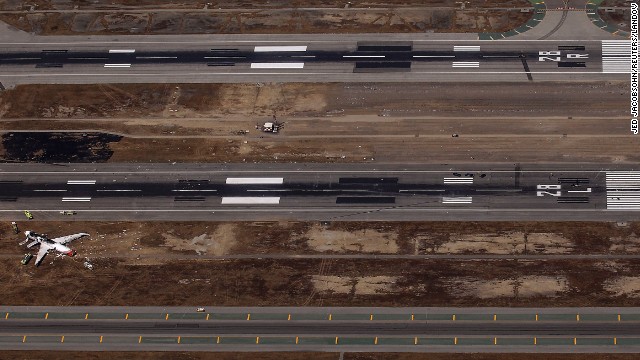 An aerial view shows the site of the crash landing between the runways on July 6.
An aerial view shows the site of the crash landing between the runways on July 6. 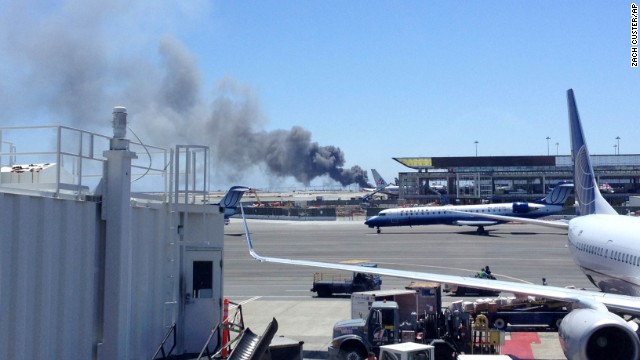 Smoke rises from the crash site on July 6 at the airport in San Francisco.
Smoke rises from the crash site on July 6 at the airport in San Francisco. 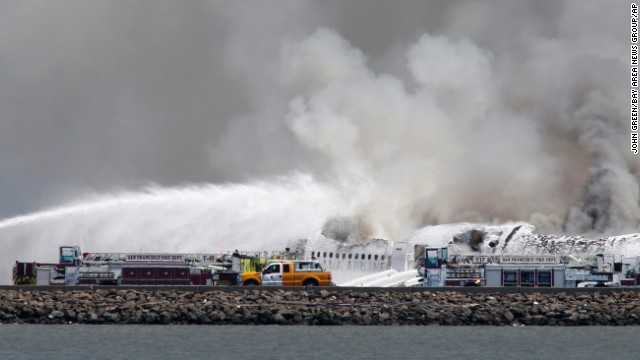 Fire crews work at the crash site at San Francisco International Airport on July 6.
Fire crews work at the crash site at San Francisco International Airport on July 6.  The Boeing 777 lies burned on the runway after it crashed landed on July 6.
The Boeing 777 lies burned on the runway after it crashed landed on July 6. 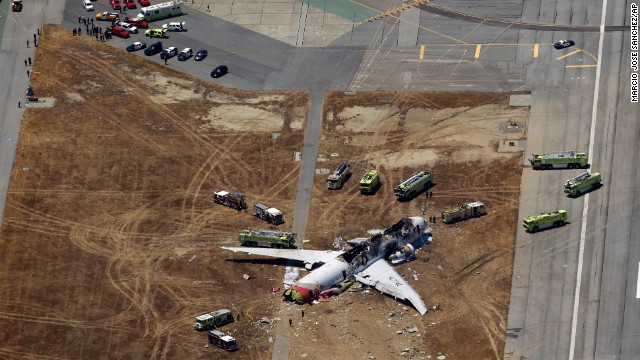 An aerial photo of the scene on July 6 shows the extent of the plane's damage.
An aerial photo of the scene on July 6 shows the extent of the plane's damage. 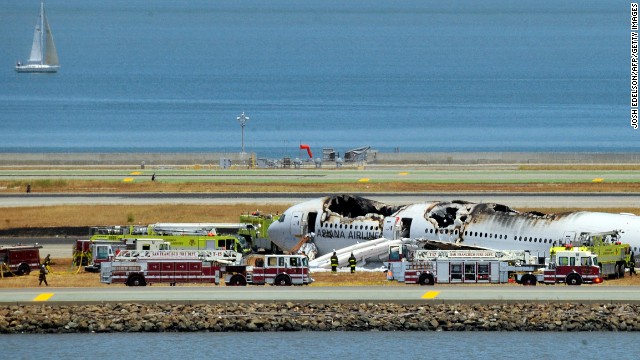 The burned-out plane sits surrounded by emergency vehicles on July 6.
The burned-out plane sits surrounded by emergency vehicles on July 6.  CNN iReporter Amanda Painter took this photo while waiting at the San Francisco airport on July 6. The entire airport has shut down and flights diverted to other airports.
CNN iReporter Amanda Painter took this photo while waiting at the San Francisco airport on July 6. The entire airport has shut down and flights diverted to other airports.  iReporter Val Vaden captured this photo while waiting in a departure lounge at the San Francisco airport on July 6. Val observed the billowing smoke and emergency responders' rush in.
iReporter Val Vaden captured this photo while waiting in a departure lounge at the San Francisco airport on July 6. Val observed the billowing smoke and emergency responders' rush in. 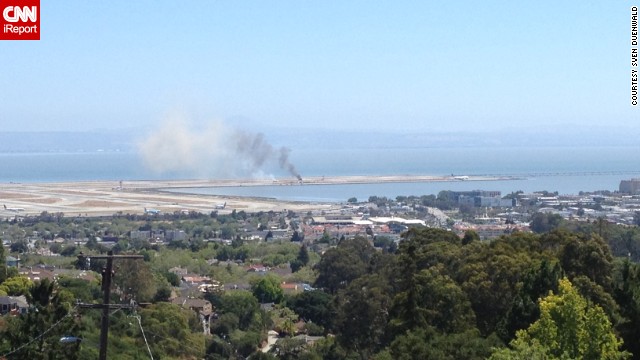 iReporter Sven Duenwald was at home on July 6 when he saw smoke rising into the air near the San Francisco International Airport.
iReporter Sven Duenwald was at home on July 6 when he saw smoke rising into the air near the San Francisco International Airport.  iReporter Timothy Clark was standing on the eighth floor of the Embassy Suites Airport Hotel when he heard a loud crashing sound from outside. "My daughter told me she heard a plane crash. I used my camera to get a clearer view and I could see a dust cloud. Then people running from the plane, then flames," he said.
iReporter Timothy Clark was standing on the eighth floor of the Embassy Suites Airport Hotel when he heard a loud crashing sound from outside. "My daughter told me she heard a plane crash. I used my camera to get a clearer view and I could see a dust cloud. Then people running from the plane, then flames," he said. 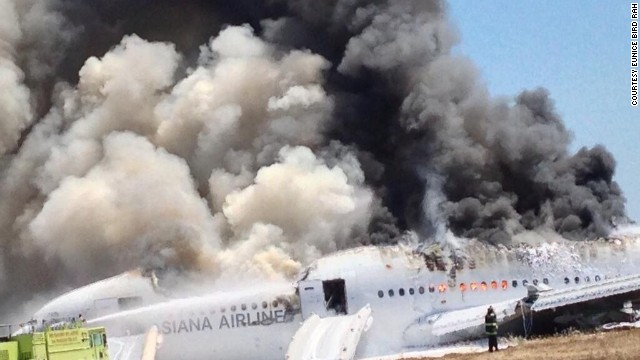 A photo provided to CNN by Eunice Bird Rah -- and shot by her father, who was a passenger on the plane -- shows flames and smoke bursting out of many of the aircraft's windows.
A photo provided to CNN by Eunice Bird Rah -- and shot by her father, who was a passenger on the plane -- shows flames and smoke bursting out of many of the aircraft's windows. 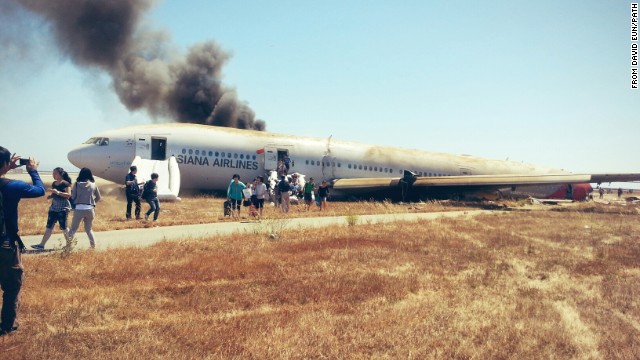 David Eun, a passenger on Asiana Airlines Flight 214, posted this image to Path.com along with the message, "I just crash landed at SFO. Tail ripped off. Most everyone seems fine, I'm ok. Surreal..." It was one of the first photographs taken after the crash.
David Eun, a passenger on Asiana Airlines Flight 214, posted this image to Path.com along with the message, "I just crash landed at SFO. Tail ripped off. Most everyone seems fine, I'm ok. Surreal..." It was one of the first photographs taken after the crash. Plane crash-lands in San Francisco
Plane crash-lands in San Francisco
Plane crash-lands in San Francisco
Plane crash-lands in San Francisco
Plane crash-lands in San Francisco
Plane crash-lands in San Francisco
Plane crash-lands in San Francisco
Plane crash-lands in San Francisco
Plane crash-lands in San Francisco
Plane crash-lands in San Francisco
Plane crash-lands in San Francisco
Plane crash-lands in San Francisco
Plane crash-lands in San Francisco
Plane crash-lands in San Francisco
Plane crash-lands in San Francisco
Plane crash-lands in San Francisco
Plane crash-lands in San Francisco
Plane crash-lands in San Francisco
Plane crash-lands in San Francisco
Plane crash-lands in San Francisco
Plane crash-lands in San Francisco
Plane crash-lands in San Francisco
Plane crash-lands in San Francisco
Plane crash-lands in San Francisco
Plane crash-lands in San Francisco
Plane crash-lands in San Francisco
Plane crash-lands in San Francisco
Plane crash-lands in San Francisco
Plane crash-lands in San Francisco
Plane crash-lands in San Francisco
Plane crash-lands in San Francisco
Plane crash-lands in San Francisco
Plane crash-lands in San Francisco
Plane crash-lands in San Francisco
Plane crash-lands in San Francisco
Plane crash-lands in San Francisco
Plane crash-lands in San Francisco
Plane crash-lands in San Francisco
Plane crash-lands in San Francisco
Plane crash-lands in San Francisco
Plane crash-lands in San Francisco
Plane crash-lands in San Francisco
Plane crash-lands in San Francisco
 Plane crash-lands in San Francisco
Plane crash-lands in San Francisco  Asiana: Pilot error was a factor in crash
Asiana: Pilot error was a factor in crash  NYT: Asiana blames software for crash
NYT: Asiana blames software for crash  2013: Chilling new video of Asiana crash
2013: Chilling new video of Asiana crash Arnold, investigators believe, experienced the same type of "mode confusion" that caught Asiana's pilots off guard -- at a much lower altitude -- shortly before they plowed into the sea wall at San Francisco International Airport.
In both cases, the pilots believed they had selected modes of autopilot and auto-throttle that would "wake up" the auto-throttle if necessary, much as a car's cruise control kicks in when the car heads uphill. But they hadn't.
Complex system
There lies the big question before the National Transportation Safety Board when it meets Tuesday: Is Boeing to blame for creating a system so complicated that it befuddled even a top FAA test pilot?
Are the pilots to blame for not understanding the intricacies of the system and for failing to monitor the plane's speed?
Or is Korea-based Asiana Airlines to blame for not adequately training its pilots?
At a December hearing on the crash, experts told the safety board that while automation has vastly improved aviation safety, it has a flip side.
The same technology that makes it possible for pilots to fly coast to coast without touching a yoke are complicated and hard to master.
Thus, flying is getting easier and harder at the same time.
"Automation can be extremely supportive of human operators if it is designed properly," expert Nadine Sarter of the University of Michigan testified. "But we also have seen in a number of incidents (where) automation can actually get in the way."
"We have heard things like 'clumsy' automation, where automation ... helps the most when the pilot actually might need the help the least. But when they need the help the most -- in very time-critical conditions -- it might be very difficult for them to actually operate the automation," she said.
Different opinions
Not surprisingly, Asiana Airlines, the pilots union, and Boeing, which manufactured the 777 involved in the crash, have starkly different opinions of what role the pilots played in the crash, and the role of automation.
"The airplane and all airplane systems were functioning as expected prior to impact and did not contribute to the accident," Boeing said in a March submission to the safety board. The accident was caused by the pilots' failure to monitor and control the plane's airspeed and direction, and could have been avoided if they had initiated a timely go-around.
Asiana, meanwhile, blamed Boeing and the pilots. The pilots, just three months before the accident, had received "specific instruction" about the possibility the airspeed protection would be disabled in a certain mode, Asiana said.
The airline assigned blame to the pilots for not ensuring "a minimum safe airspeed," and Boeing for creating an autopilot system that led to an "unexpected disabling" of speed protections.
The warning system, the airline says, also did not give the pilots enough time to recover.
The Asiana Pilots Union blamed crew training, saying pilots were not trained that a combination of autopilot and auto-throttle modes would not prevent the plane from going too slowly.
"In this case, a key piece of information was not provided as part of the normal training program at Asiana," the union said.
Boeing said it was without fault.
"All airplane systems were functioning as expected prior to impact and did not contribute to the accident," it told the safety board.
Asked why the "hold" mode did not protect against dangerous drop-offs in speed, Boeing told the board, "To do this would violate (Boeing's) design philosophy: the pilot is the final authority for the operation of the airplane."
"If the auto-throttle automatically (switched mode to prevent an aerodynamic stall), it would be overriding the crew's selection," Boeing said.
Fly the plane manually
If pilots are confused by the technology, there is a simple solution: Fly the plane manually, Boeing said.
"This accident would have been avoided had the flight crew followed procedures and initiated a timely go-around," Boeing told the safety board.
What no one contests is that by the time the plane's captain recognized the plane was traveling too slowly, it was too late.
At 11 seconds before impact, the plane's low airspeed alert was triggered.
Eight seconds before impact, one of the pilots pushed the throttles forward. But it takes engines seven to eight seconds to spool up from idle to full power.
The plane slammed into the seawall, ripping off the landing gear, the tail and both engines. It spun 330 degrees in a shower of sparks and debris.
Of the 307 people on board, three died. Almost 200 were injured.
Asiana Airlines fined $500,000 for failing to help families
Asiana crash victims sue Boeing
No comments:
Post a Comment